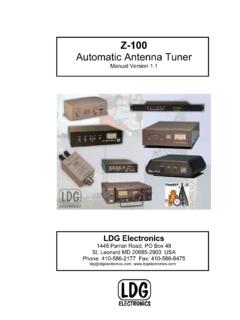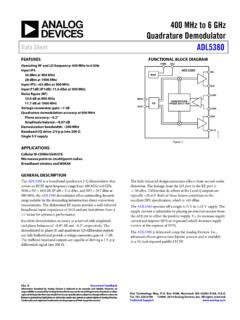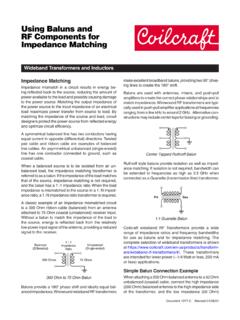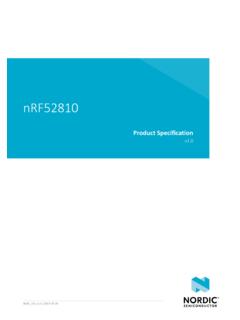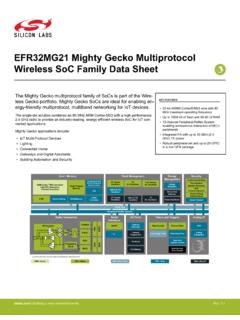Transcription of The ZS6BKW Multi-band HF Antenna
1 The ZS6 BKW Multi-band HF AntennaApril 7, 2017 This is the Antenna for you guys who want to get on HF effectively and haven t too much space or cash to throw around. Actually, it s a design from ZS6 BKW (akaG0 GSF), similar to the G5RV, but it actually resonates on five bands, (well 6, actually) and doesn t rely on a tuner (ATU) to make it work. The design appeared in TT (RadCom) Jan & Feb 1993, but is also in Pat Hawker s Antenna Topics ( 2002) It s only 90 ft long ( meters), with a 40 ft ( m) - Horizontal or inverted V layoutSo, it s a cousin to the G5RV (which only resonates on 14 & 24 MHz), but better asit needs no ATU on 40, 20, 17, 12, 10 and 6 simplicity, I set this Antenna up as an inverted-v configuration.
2 The reason wassimple you only need one support to hold it up, not two. I also had the club s MFJA ntenna Analyzer with me so that I could see what was happening. I recorded the data (see below).Incidentally, all center-fed antennas can be supported by just one mast, with the ends left to droop down. The rule of thumb is that the angle at the apex should never be less than 90 degrees, otherwise cancellation between the two halves occurs. Furthermore, as it is the current peaks along an Antenna that do most of the radiation, having the center at the highest point is a positive advantage, rather than supported at each end with a big droop at the center (current point nearest to ground).
3 This is another reason for not being too fussy about the ends of a center-fed Antenna being lower, or bent around. It will have minimal effect on radiation efficiency. The main thing is never have the ends dropping right down to ground level because the ground will seriously de-tune the Antenna and it will not work. I ve tried it. Just a yard or so off the ground makes all the difference. Simply have end insulators (or plastic strips, etc), then wire or twine to the tying-off points. This effectively raises the ends of the Antenna sufficiently clear of the ground.
4 It isbest to have each wire's endpoint at a 45 degree angle to the apex of the , the BKW can be horizontal (two supports) or inverted-v layout (single support), as shown. Incidentally, the same applies to a simple Antenna wire can be solid copper, stranded, insulated or not. A lot of rubbish is printed about the merits or otherwise of different sorts of wire. It s largely hogwash. Wire is wire at these frequencies. In the original design, 300 ohm twin was used, but I prefer the 450 ohm stuff. It s much stronger - and losses, especially in wet weather, are lower when impedances are high down the line.
5 Back in 1985, 450 twin wasn t readily available, there was only 75 and 300 twin, or the option of making your own open-wire feeders (which actually are the best of all around 600 ohm, but these do tend to twist or get caught in trees etc! Yes bitter experience and soldered jointshere too!)Finally, if you want to use it on other HF bands ( , 10, 21 MHz), an ATU (just like at the bottom of your 5RV!) will do the business, but preferably at the bottom of the 450 ohm feeder with a balanced output, not after a length of 50 ohm coax, if you ve had to use it to reach your rig.
6 Of course for MHz (160m), you could short out the feeder twin, and feed it like a Marconi Antenna , with a suitable ATU. Not very clever, are the MFJ figures I recorded on the test Antenna :Best in-band frequency SWR R at MHz (80m) 7:120tunes easily with MHz (40 m) 1 MHz (30 m) highhigh needs MHz (20 m) 1 MHz (17 m) 1:150 below :1 in 18 MHz MHz (15m) highhighneeds MHz (12 m) 2:1100 OK, even without MHz (10 m) :160No sweat! MHz (6 m) :160A surprise: 6m. Too!
7 Just to show the proof in the pudding , I used it on 7 and 14 MHz, and got excellent reports, as one would expect with a half-decent Antenna ! Didn t have time to use it on all bands, but I leave that to you (to tell everyone how good it is).Martyn Vincent G3 UKVK evin VK2 FUO advises to put a 1 to 1 current balun on the ZS6 BKW Antenna 450 ohm feeder line where it joins the 50 ohm coax to the acknowledges author Martyn G3 UKV
